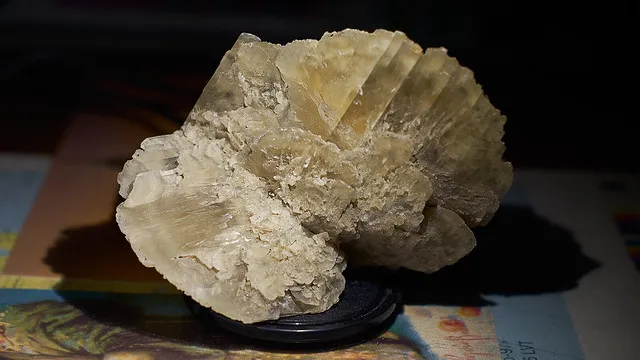
Appearance
The presence or absence of impurities in gypsum can affect its color. It is typically found in colorless, gray, or white shades. But when contaminants are present, it can also display colors like brown, pink, or yellow. Gypsum crystals range in transparent from translucent to transparent, letting different amounts of light through. The quality of the crystal and the existence of contaminants determine the transparency level.
When subjected to mechanical tension, gypsum rapidly splits into thin, flat sheets or plates due to its excellent cleavage in one direction. It is appropriate for the production of plaster and gypsum board (drywall) due to this characteristic. Fresh, undamaged gypsum has a pearly to vitreous (glassy) luster on its surfaces. In some creative and ornamental uses, this feature adds to its visual appeal.
Geographical Distribution
There are deposits of gypsum in different degrees of purity and quantity across the world. The various conditions under which gypsum originates are reflected in the variety of geological environments in which these deposits occur. The United States, Mexico, Canada, Europe, the Middle East, North Africa, Australia, and North America are a few of the most notable regions.
History
Greek word γύψος (gypsos), meaning “plaster,” is the source of the English word gypsum. This dehydrated gypsum became known as plaster of Paris because the Montmartre neighborhood of Paris has long provided burnt gypsum (calcined gypsum) utilized for numerous uses.
Because of its crystalline projections, gypsum was referred to as “spear stone” in Old English, or spaerstān. In contrast to gypsum, any non-ore mineral or crystal that develops in spear-like projections is referred to as a spar in mineralogy. German clergyman and agriculturalist Johann Friderich Mayer looked into and promoted the use of gypsum as fertilizer in the middle of the eighteenth century. Gypsum was considered an almost miraculous fertilizer in the early 19th century and may serve as a supply of sulfur for plant growth. The need for it among American farmers was so great that a thriving contraband trade developed with Nova Scotia, which culminated to the 1820 “Plaster War”
Metaphysical Properties
Metaphysically, gypsum is a potent energy conductor that promotes energetic flow, cleansing, obstruction removal, strengthening, and damage restoration to desired energetic balance because of its polar molecule structure. It’s a great instrument for removing auric entanglements and other crystals.

Chemical Composition
The main atoms that make up gypsum’s chemical composition are calcium, sulfur, oxygen, and hydrogen. According to its chemical formula, CaSO4·2H2O, one atom of calcium (Ca), one atom of sulfur (S), four atoms of oxygen (O), and two molecules of water (H2O) make up each unit of gypsum. Gypsum has a distinct hydrated form because of the structural bond between the two water molecules and the calcium sulfate.
Types
Gypsum can be found in nature as translucent, cleavable masses known as selenite and as flattened, frequently twinned crystals. No considerable amount of selenium is present in selenite; instead, the names of both compounds come from the ancient Greek term for the moon.
It is also known as “satin spar” when selenite is found in a silky, fibrous form. Lastly, it could also be fairly compact or granular. It can be clear or opaque in samples the size of your hand. Alabaster is a highly valued material for a number of ornamental applications. It is a very finely grained white or slightly tinted type of gypsum. Desert rose refers to the opaque, flower-like gypsum that is found in arid regions and contains embedded sand grains.
Uses
- Construction: Gypsum is a common building material in construction. Common goods made from gypsum include plaster of Paris and gypsum board (drywall). Gypsum board is used for building interior walls and ceilings, whereas plaster is utilized to create decorative finishes on walls and ceilings.
- Agriculture: In agriculture, gypsum is added to the soil to enhance its structure and lessen compaction. It helps restore saline or sodic soils and gives plants the vital minerals calcium and sulfur.
- Industrial Applications: Gypsum is used in many industrial processes, such as the creation of cement, as a filler in textiles and paper, and as a component of molds and casts.
- Art and Sculpture: The use of gypsum in sculpture and art dates back many years. It is used by artists to make complex sculptures and casting molds.
Table





